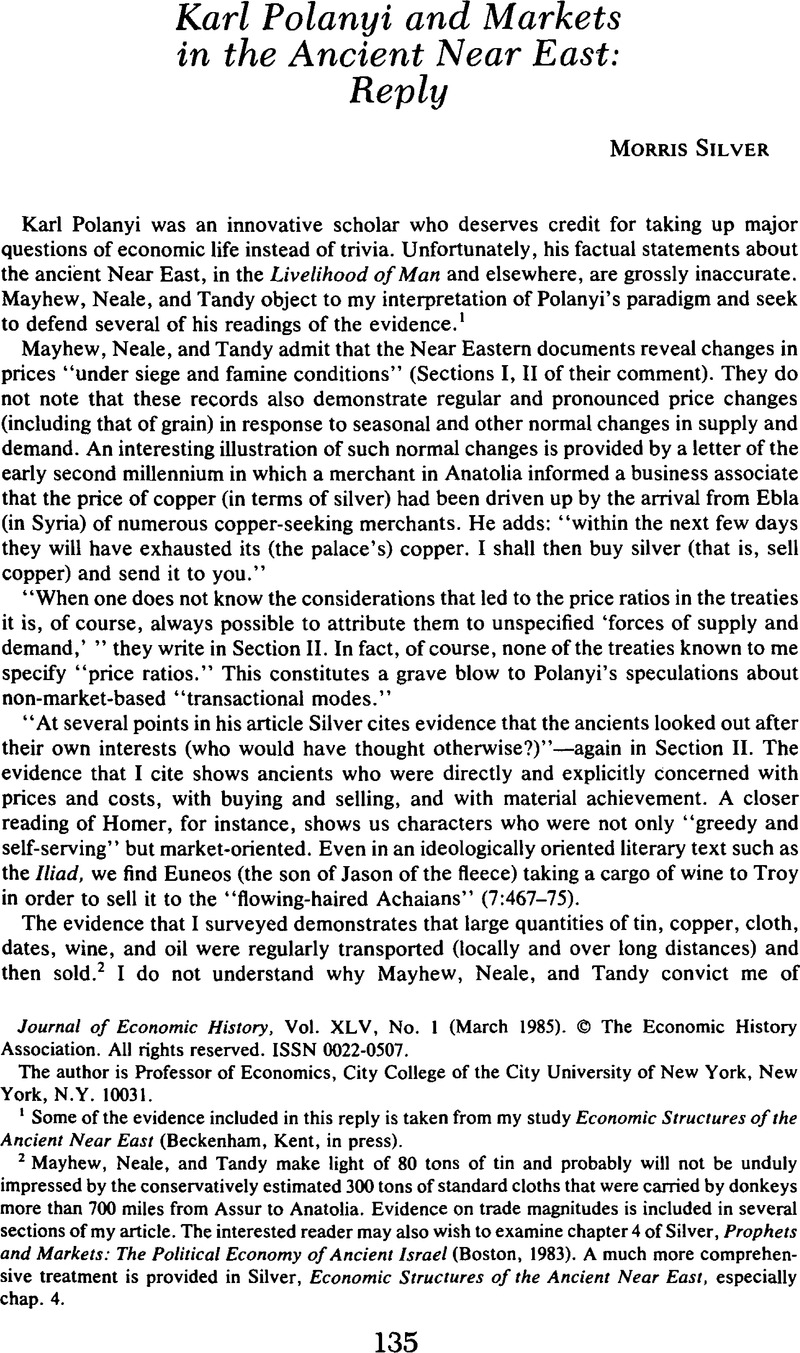No CrossRef data available.
Published online by Cambridge University Press: 03 March 2009

1 Some of the evidence included in this reply is taken from my study Economic Structures of the Ancient Near East (Beckenham, Kent, in press).Google Scholar
2 Mayhew, Neale, and Tandy make light of 80 tons of tin and probably will not be unduly impressed by the conservatively estimated 300 tons of standard cloths that were carried by donkeys more than 700 miles from Assur to Anatolia. Evidence on trade magnitudes is included in several sections of my article. The interested reader may also wish to examine chapter 4 of Silver, , Prophets and Markets: The Political Economy of Ancient Israel (Boston, 1983).CrossRefGoogle ScholarA much more comprehensive treatment is provided in Silver, Economic Structures of the Ancient Near East, especially chap. 4.Google Scholar
3 Polanyi defines “economic solipsism” as the view that “Men would barter unless they were prohibited from doing so, and markets would thus come into being unless something was done to prevent it” (Pearson, Harry W., ed., Livelihood of Man [New York, 1981], Pp. 14–15).Google Scholar I fully subscribe to this view and, indeed, the “solipsist” assumption underlies the model of “The Decline and Revival of the Market” I put forward in Affluence, Altruism, and Atrophy (New York, 1980). Perspective on Polanyi's position is gained by remembering that Polanyi was revolted by the market system of the modern West, which he saw as having turned both man and nature into fodder for the satanic mill of the self-regulating market system. Polanyi's editor, Harry W. Pearson, explains that “The driving force behind all his historical work was the conviction … that it had been possible to produce and distribute the livelihood of man while maintaining the integrity of society, and that pre-market history offered many clues to the possibility of returning the mandate for man's fate to the variegated social, political, and cultural institutions of society” (page XXXVI). Polanyi's efforts in this direction must be judged a failure on both theoretical and empirical grounds.Google Scholar
4 I find it difficult to follow their discussion in Section IV. Surely they are aware that Greece produced olive oil (and wine) for export and that southern Babylonia exported dates.Google Scholar
5 For a convenient summary, see Larsen, M. T., “Early Assur and International Trade”, Sumer, 35 (1979), pp. 349–47.Google Scholar
6 Geib, I. J., “The Ancient Mesopotamian Ration System”, Journal of Near Eastern Studies, 24 (1965), Pp. 230–43. In line with Gelb's position we should assume that the “female mill workers” mentioned on page 809 were slaves and translate “barley rations” not “barley wages”.Google Scholar
7 Komoroczy, G., “Landed Property in Ancient- Mesopotamia and the Theory of the So-Called Asiatic Mode of Production,” Oikumene, 2 (1978), p. 7.Google Scholar
8 In some instances, however, apparently exogenous changes in physical environment (such as soil salinization) or shifts in population are in reality endogenous reactions to market forces of the usual kind.Google Scholar
9 The underlying theory is provided in Silver, , Enfrrprise and the Scope of the Firm: The Role of Vertical Integration (Oxford and New York, 1984), in which Chapter 7 considers “The Rises and Falls of Manors, Latifundia, and Bonanzas.”Google Scholar